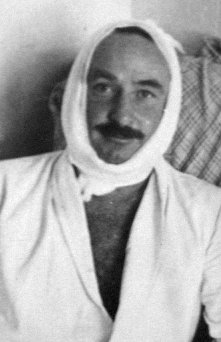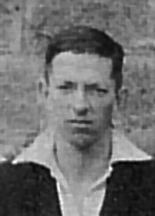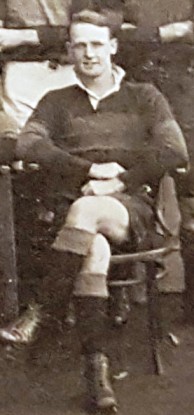View entry
Name: MAYERS, Raymond Sidney MBE



Nee: son of George Russell Mayers of Miwani
Birth Date: 6 Oct 1908 Croydon, New South Wales
Death Date: 1993 Voi
First Date: 1935
Last Date: 1993
Profession: Tea farmer
Area: Tanganyika, Nandi, Miwani, Donyo Sabuk, Voi, 1930 Kiamara Estate, Kiambu, MacKinnon Road, Namanga River Lodge, Narok
Married: 1931 Helen Jane Douglas b. 1908 S. Africa, d. 17 Nov 1978 Kenya (dau of Hector Douglas)
Children: Patricia (Robertson) (31 July 1933)
Book Reference: Sitrep 2, Bwana, Golding, Celluloid, Red 31, mini-Sitrep 8, Hut, Stud, Kingsley-Heath
General Information:
One of the original '500' men in the Kenya Regt. in 1937. (KR 488).
Sitrep 2 - 'Ray as you know is a great extrovert. He enjoys life to the full, loves having people around him - is a marvellous host, but a rotten guest! He is generous to a fault and his hospitality is legendary. Nobody has ever been turned away from his door. ........ He loves his parties, enjoying stimulating conversation, a good argument and entertaining people with his party tricks ......... . On the serious side, he is an extremely able administrator; has always enjoyed the challenge of starting an enterprise, getting it going and then moving on to new fields. Ray returned to Kenya in 1931 (and has not left EA since) having spent a couple of years up at Cambridge, where Joe and Clive, who was up at the same time, learnt to fly. They had a slight mishap on one occasion that put the Ford car factory out of action for a day! Ray's Kenya flying licence is No. 11 but thankfully he hasn't flown for many years. Ray married Helen, whom he had met while working at Kiamara within a few weeks of his return. Their honeymoon was spent driving to Tanganyika, with Cyril as company. They had bought land at Mufundi, in the Highlands, which they cleared and planted tea - the first to be planted in Tanganyika - Ray did a bit of prospecting on the Lupa Goldfields while Helen watched the farm. Once a month she and a friend would tour the goldfields selling farm produce - all this to keep going while the tea grew. ........... On returning to Kenya, Ray and Helen went into the tourist business. They built Namanga River Camp near Amboseli and used to take out hunting and photographing parties. Little did they know how that industry was to flourish. A lot of the original Namanga is still there today.
The war years saw Ray with the 5th KAR mostly in Somalia. Here again he was able to show his individualistic streak. He was posted to the Ogaden, a no mans land even then where the shifta were at large. ........ (more) .....…..
After the war Ray leased a farm at Mau Nandi on the Soldier Settlement Scheme. One of the conditions of the S.S.S. was that all leasees should attend Egerton Agriculture College at Njoro, regardless of age or experience. There were 3 courses a year. Ray was enrolled for the 6 month course. The farm was only 18 miles away, up a very tough track (once again he was opening up new land, this time wheat and pyrethrum). Ray and some of his fellow students spent weekends on the farm - these weekends became rather extended. The Principal suggested he should return for a 2 month course! This time a much younger pupil complained that he could never get into the bathrooms because the wives of S.S.S. students were always using them. Ray sorted the problem by letting off a fire extinguisher through the keyhole. On another occasion he couldn't put his light out; so he stuck it under his bedclothes and started a fire. He was asked to return for the 1 month course! In the late 50's Ray was asked if he would act as British Consul at Mega, on the Kenya/Ethiopian border, for 6 months. .......
Ray enjoyed the months at Mega, though there were a few horrifying aspects, like prisoners being kept in irons and if they had no families to feed them just died - Things totally alien to his principles ....….
Emergency and Ray Force ......... Then there was Donya Sabuk ....... he spent a couple of years managing a sisal estate - ex Northrup MacMillan - for a wily Jewish lawyer, who used him unmercifully. Fortunately Ray fell foul of the local African politician and got thrown out of the area. Ray's next enterprise was starting the ranch at Voi. Everyone thought he was mad - this was "Man Eaters of Tsavo" and tsetse fly country with no water. He was undaunted. While negotiating the project Ray set up an elaborate camp on the banks of Voi river under huge wild fig trees - the environment he is happiest in; he's a nomad at heart. The camp became a "watering hole" for everyone travelling on the Nairobi/Mombasa road - both ways. The project went through and Ray has spent the last 23 years developing the ranch. It wasn't easy. The elephants dug up his pipelines, and demolished the water tanks; lions raided his cattle bomas; buffalo carrying rinderpest crossed over from Tsavo park ..............
The ranch has become a permanent "watering hole" for travellers, known and unknown - none were ever turned away. Sometimes there were more for breakfast than had spent the night! (Ray maintains the ideal guests are the ones who arrive in the evening and leave before breakfast!) The ranch has also become an experimental place. Ray is always prepared to try out new ideas and has had American and Israeli agrics to do experiments. It was on the ranch that Jajoba was first tried. A few seeds were brought in from Israel by Graham Boswell, were planted and flourished. From this grew one of the largest plantations of Jajoba in the world. So he still goes on. (article by Ray's daughter Patricia Robertson)
Golding - Shifta - Major Ray Mayers, a farmer from Kenya, who was political officer at El Carre. By then the shifta were raiding in larger bands, sometimes hundreds strong ....... Took on a large shifta gang, who realised they were only opposed by a very small party and started to deploy through the bush. Before long Ray was surrounded, the Sten gun firmly jammed, and he with his .303 had the support of 2 untrained men with Italian carbines to oppose the increasing numbers of shifta ...... it was not long before he was surrounded by a tight circle of shifta, some so close that in one instance he shouted "jogso" (stand up!) and when one of the nearest jumped up from behind his rock cover, Ray shot him dead. .......... section of gendarmerie arrived just as Ray was deciding that he would keep his last bullet for himself ....... Ray told me that the relief was so sudden and so great - the shifta being notorious for the unpleasant practices they employed on their captives - that he was physically sick with relief.
Celluloid - Namanga River Camp, almost on the border of Kenya and Tanganyika ...... Mr Ray Meyers (sic) in charge of the camp ...... 50 miles from Namanga, a camp had been set up on the edge of a spacious salt lake. Accompanied by Ray Meyers, we set out next morning to visit "Rhino Camp".
mini-Sitrep 8 - Mayers was a case of the right man in the right place. Son of an Australian sugar baron (Mayers Street is the main thoroughfare through Cairns in Queensland), Ray's father left Australia when labour unions were formed, and settled in Kenya before the First World War to grow sugar near Kisumu. Ray was the youngest of a large family, who were wealthy enough to allow him a privileged upbringing, and he enjoyed an extravagant lifestyle in the 1930s until, whilst an undergraduate at Cambridge University, he was informed that the family business was bankrupt and he would have to get a job. For the next five years Ray worked, farmed, hunted and panned for gold in Tanganyika and Kenya. He married Helen Douglas who bore his only child Patricia.
At the outbreak of WW2, Ray joined the Army and when Italy entered the War he was part of Brig. Fluffy Fowkes' EA Division that advanced, moving north to Hargeissa, then hooking westward into Ethiopia. As the Italians collapsed, anarchy reigned, and weapons fell into the hands of the aggressive tribesmen who attacked convoys as well as each other. Mayers got the job of bringing peace and order to this situation, and was appointed Military District Commissioner, then later Military Governor in the Ogaden, a vast arid area of Somalia, which he governed for almost 10 years.
Unlike most Europeans Ray loved Somalis, and got on well with them, respecting their toughness, and understanding and manipulating their deviousness to his own advantage. In turn they reciprocated, with dedication and loyalty and he retained Somalis on his personal staff until he died. In 1950 the area was ceded to Ethiopia under a UN mandate. This incredibly unjust and arbitrary decision incensed Ray and he resigned his post rather than lower the British Flag at El Carre, his post where the handover took place. The subsequent turmoil and bitter fighting over this territory cost thousands of lives, and indirectly led to the eventual collapse of Somalia.
Mayers returned to Kenya to farm at Mau Narok. He joined the Kenya Regiment as a weekend soldier, resuming the settler life which was hard work and financially risky, but attracted men and women who were tough and independent, and knew how to enjoy themselves. They were investing their life and savings into the land they loved, for a future for their children and grandchildren, not realising that their ideals were totally unrealistic, and the dream would shortly collapse. .......... (Mau Mau and Ray Force) ........…..
Filo's bar in Fort Hall was the popular meeting place, and impromptu parties developed whenever the chance occurred. Ray would perform 'the Muffin Man' a tricky contortion, by balancing a pint of beer on his forehead, while singing the muffin song and slowly lying down on the floor, then restanding without spilling a drop. At other times he might show off his fire blowing act. He would take a mouthful of kerosene and blow it in a spray through a lighted wad of methylated spirit - producing a long fiery jet, singeing curtains, furnishings and the eyebrows of onlookers. (He is reported to have once burned a house down, when the thatch caught fire.) He dispensed with military vehicles using his own new Vauxhall Velox, a very smooth saloon car. His driver, Peter Reynolds was a lanky youngster who had worked on his farm and drove his Bedford truck as an escort. He was regularly dispatched to buy more beer in town. Ray carried a fancy leather brief case which I saw him open one day - it was velvet lined, with indentations for carrying a bottle of Gordons Gin, bitters, olives and crystal glasses. Ray Mayers returned to his farm but it was not a financial success and he joined another group, farming at Donyo Sabuk. Eventually he formed a partnership with the Teita tribe on 90000 acres of arid rangeland near Voi, running 5000 head of cattle, helped by his grandson. He ran an open house, made of poles and hessian cloth painted with a cement wash, and a thatched coconut frond roof on the side of Rukinga Hill. He proudly announced that the walls were sewn in one day by his wife Helen. Here he looked over the Tsavo National Park from his verandah, watching the magnificent panorama of wildlife, as he entertained his numerous guests with gin and tonics and beers, summoning his Somali staff with a long string attached to a wooden camel bell in the kitchen. He died there in January 1993 in his 85th year.
EA Stud Book 1954 - Pigs - Large Whites - R.S. Mayers, Njoro
Bwana - Namanga Hotel, owned by Gethin & Hewlett - 1935 - new manager Ray Mayers arrived with his wife Helen; he and his wife became great friends of George Adamson.
Played rugby for Thika/Ruiru.
